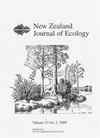Effect of pitfall trap design on internal trap temperature and the implications for live-trapped lizards
IF 1.4
3区 环境科学与生态学
Q3 ECOLOGY
引用次数: 0
Abstract
: The capture of animals in live traps poses inherent risks of heat stress and mortality to trapped individuals. Despite a long history of pitfall trap use in New Zealand for monitoring small lizards, the design of traps and their covers often varies; however, the effects that this has on the internal temperature of the traps is unknown. Poor trap design may increase the risk of stress and mortality if internal temperatures exceed thermal limits. We tested the influence of three aspects of trap design (cover material, cover colour, and internal trap size) on the maximum and mean internal trap temperatures at Kaitorete Spit, New Zealand. Temperatures were recorded with dataloggers across 24 days during midsummer (December 2020 to January 2021). Internal temperatures reached a maximum of 38.2 ° C (on a day with a maximum air temperature around 31 ° C). Those trap temperatures are above predicted harmful thermal limits of some New Zealand gecko species and levels that induce avoidance behaviour in some skinks. Maximum temperatures were lower under plywood covers than those made of plastic or Onduline, brown covers than black, and in 4 L traps rather than 1 L. The best trap design had thermal maxima 3.9 ° C lower than the worst design, averaging 4.9 ° C above air maximum temperatures in the best design compared with 8.6 ° C above for the worst. As climate change increases temperatures in some areas, the risk of heat stress and mortality rises for lizards constrained in pitfall traps. We recommend the use of plywood covers and larger internal trap sizes to reduce this risk.陷阱设计对内部陷阱温度的影响及其对活体蜥蜴的启示
:用活捉诱捕器捕获动物会给被诱捕者带来热应激和死亡的固有风险。尽管新西兰使用陷阱来监测小型蜥蜴的历史悠久,但陷阱及其覆盖物的设计往往各不相同;然而,这对陷阱内部温度的影响是未知的。如果内部温度超过热极限,不良的疏水器设计可能会增加压力和死亡的风险。我们在新西兰Kaitorete Spit测试了存水弯设计的三个方面(盖子材料、盖子颜色和内部存水弯尺寸)对最高和平均内部存水弯管温度的影响。仲夏期间(2020年12月至2021年1月),数据记录器记录了24天的温度。内部温度最高达到38.2°C(当天最高气温约为31°C)。这些诱捕器的温度高于一些新西兰壁虎物种的有害温度极限,也高于一些壁虎的回避行为。胶合板覆盖物下的最高温度低于塑料或Onduline制成的覆盖物,棕色覆盖物低于黑色覆盖物,4L存水弯的最高温度高于1L。最佳存水弯设计的最高温度比最差设计的低3.9°C,最佳设计的平均温度比空气最高温度高4.9°C,而最差设计为8.6°C。随着气候变化,一些地区的气温升高,被困在陷阱中的蜥蜴面临热应激和死亡的风险也会增加。我们建议使用胶合板覆盖和较大的内部存水弯尺寸来降低这种风险。
本文章由计算机程序翻译,如有差异,请以英文原文为准。
求助全文
约1分钟内获得全文
求助全文
来源期刊

New Zealand Journal of Ecology
环境科学-生态学
CiteScore
3.00
自引率
12.50%
发文量
35
审稿时长
>36 weeks
期刊介绍:
The New Zealand Journal of Ecology is a biannual peer-reviewed journal publishing ecological research relevant to New Zealand/Aotearoa and the South Pacific. It has been published since 1952 (as a 1952 issue of New Zealand Science Review and as the Proceedings of the New Zealand Ecological Society until 1977). The Journal is published by the New Zealand Ecological Society (Inc.), and is covered by Current Contents/Agriculture, Biology and Environmental Science, GEOBASE, and Geo Abstracts.
 求助内容:
求助内容: 应助结果提醒方式:
应助结果提醒方式:


